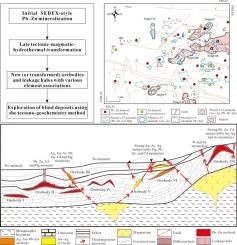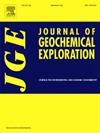利用构造地球化学方法勘探中国西城西部矿田隐伏矿床
IF 3.4
2区 地球科学
Q1 GEOCHEMISTRY & GEOPHYSICS
引用次数: 0
摘要
地球化学异常涉及复杂的地质和地球化学过程。将成矿过程纳入地球化学数据的解释可促进矿产勘探。本研究从西城矿田西部采集了 3080 个子样品,并采用构造地球化学方法将其组合成 1312 个复合样品。每个复合样本分析了 19 种元素。基于 CLR 变换数据的因子分析得出了四个因子,包括 F1 的 Ag-Sb-Hg-Pb-Au-(B-Ba) 关联、F2 的 Zn-Cd-Pb 关联、F3 的 Bi-Sn-(Au-As)关联和 F4 的 W-Sn-(Cu)关联。利用浓度-数量(C-N)分形模型得出了每个因子的阈值。根据因子异常图划分了六个靶区,并分别在靶区 I 和靶区 II 发现了一个铅锌矿床和两个金矿床。这些发现以及已知矿床与异常点之间良好的空间对应关系为构造地球化学方法在研究区域的有效性提供了有力证据。更重要的是,构建了地球化学异常与金属生成之间的遗传关系模型。晚期构造-岩浆-热液转化主导了研究区的地球化学模式。富金岩浆-热液与 SEDEX 型铅锌矿化之间的相互作用程度产生了具有不同元素组合的漏磁晕。此外,W-Sn 异常可作为金矿化的辅助勘探指标。本文章由计算机程序翻译,如有差异,请以英文原文为准。

Hidden deposit exploration using the tectono-geochemistry method in the western Xicheng ore field, China
Geochemical anomalies involve complex geological and geochemical processes. Integrating metallogenic processes into the interpretation of geochemical data can promote mineral exploration. In this study, 3080 subsamples were collected from the western Xicheng ore field and combined into 1312 composite samples using the tectono-geochemistry method. Nineteen elements were analyzed for each composite sample. Factor analysis based on the CLR-transformed data yielded four factors, including the Ag–Sb–Hg–Pb–Au–(B–Ba) association of F1, Zn–Cd–Pb association of F2, Bi–Sn–(Au–As) association of F3, and W–Sn–(Cu) association of F4. Thresholds of each factor were obtained using the concentration–number (C–N) fractal model. Six targets were delineated based on the factor anomaly maps, and one Pb–Zn and two Au deposits were discovered in Targets I and II, respectively. These discoveries and the good spatial correspondence between known deposits and anomalies provide compelling evidence for the effectiveness of the tectono-geochemistry method in the study area. More importantly, a model for the genetic relationship between geochemical anomalies and metallogenesis was constructed. The late tectonic-magmatic-hydrothermal transformation dominated the geochemical pattern in the study area. The degree of interaction between the Au-rich magmatic-hydrothermal fluids and SEDEX-style Pb–Zn mineralizations yielded leakage halos with various elemental assemblages. In addition, W–Sn anomalies may serve as auxiliary exploration indicators for Au mineralizations.
求助全文
通过发布文献求助,成功后即可免费获取论文全文。
去求助
来源期刊

Journal of Geochemical Exploration
地学-地球化学与地球物理
CiteScore
7.40
自引率
7.70%
发文量
148
审稿时长
8.1 months
期刊介绍:
Journal of Geochemical Exploration is mostly dedicated to publication of original studies in exploration and environmental geochemistry and related topics.
Contributions considered of prevalent interest for the journal include researches based on the application of innovative methods to:
define the genesis and the evolution of mineral deposits including transfer of elements in large-scale mineralized areas.
analyze complex systems at the boundaries between bio-geochemistry, metal transport and mineral accumulation.
evaluate effects of historical mining activities on the surface environment.
trace pollutant sources and define their fate and transport models in the near-surface and surface environments involving solid, fluid and aerial matrices.
assess and quantify natural and technogenic radioactivity in the environment.
determine geochemical anomalies and set baseline reference values using compositional data analysis, multivariate statistics and geo-spatial analysis.
assess the impacts of anthropogenic contamination on ecosystems and human health at local and regional scale to prioritize and classify risks through deterministic and stochastic approaches.
Papers dedicated to the presentation of newly developed methods in analytical geochemistry to be applied in the field or in laboratory are also within the topics of interest for the journal.
 求助内容:
求助内容: 应助结果提醒方式:
应助结果提醒方式:


